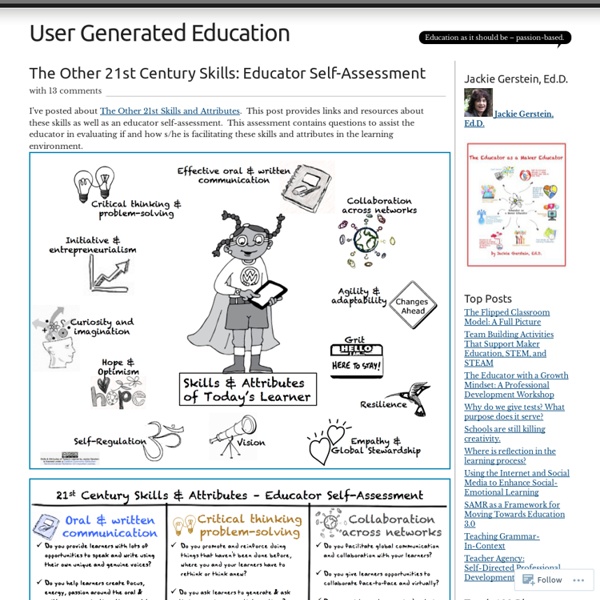Educational Technology and Mobile Learning: A Very Good Checklist for Assessing 21st Century Learning Skills
January 29, 2015 Here is another great resource from Dr. Jackie Gerstein, one of our favourite EdTech bloggers. Jackie designed this beautiful chart featuring 12 attributes and skills that teachers should tend to in their instruction. You can use it as a self-assessment checklist to help you evaluate your teaching practice. What I like the most about this chart is the fact that it emphasizes the social and affective component in learning, something which is often overlooked in today’s digitally-focused learning paradigms.
The Secret to Drawing Meaningful Reflection Out of Your Students - The Art of Ed
If your students blog about their art as mine currently do, you understand the rich reflection that blogging can produce. When students reflect on both their finished pieces and the processes they went through to create them, they tend to communicate more in writing than they would in a class critique. As you read the writing, you discover much about the art and the student’s reason for making it.
Examples of learning intentions
The learning intention is expressed in terms of knowledge, understanding and skills, and links directly with the relevant curriculum document. The design of learning intentions starts with the answers to these questions. What do I want students to know?
How to Make Time for Reflection in the Arts Classroom
Let’s be honest, when an art project goes long, or a class is a little crazy, structured reflection is the first thing to go. This happens in spite of the fact that we KNOW reflecting makes all the difference when it comes to students retaining their discoveries and being able to apply their learning in other contexts. In the words of John Dewey, “We do not learn from experience…we learn from reflecting on experience.” Like most things that are of paramount importance, creating an environment in which meaningful reflection can happen is difficult, especially if you are a teaching artist who only temporarily inhabits another teacher’s classroom.
How do You Remove the Unused Parts of Cropped Screenshots in Microsoft Office Documents?
When you add a screenshot to a Microsoft Office document and crop it, you most likely give no further thought to the unused portions, but did you know that they are still there and could pose a security risk if they contain sensitive information? Today’s SuperUser Q&A helps a worried reader retain only those parts of the screenshots needed while permanently getting rid of the rest. Today’s Question & Answer session comes to us courtesy of SuperUser—a subdivision of Stack Exchange, a community-driven grouping of Q&A web sites. The Question SuperUser reader user462760 wants to know how to stop Microsoft Office from retaining the unused parts of cropped screenshots in documents: I made a worrying discovery that after cropping a screenshot in Word, PowerPoint, and likely other Microsoft Office programs, the unused parts of cropped screenshots are retained.
Professional Learning That Matters
10 Keys to Making Professional Learning Meaningful By Samantha Cleaver Chances are, as you look at your calendar of scheduled professional learning days, you aren’t overcome with excitement.
Your Rubric Is a Hot Mess; Here’s How to Fix It.
Share with Friends 28.1KShares See Mrs. Jones.
A Taxonomy of Reflection: A Model for Critical Thinking
My approach to staff development (and teaching) borrows from the thinking of Donald Finkel who believed that teaching should be thought of as “providing experience, provoking reflection.” He goes on to write, … to reflectively experience is to make connections within the details of the work of the problem, to see it through the lens of abstraction or theory, to generate one’s own questions about it, to take more active and conscious control over understanding. ~ From Teaching With Your Mouth Shut Over the last few years I’ve led many teachers and administrators on classroom walkthroughs designed to foster a collegial conversation about teaching and learning. The walkthroughs served as roving Socratic seminars and a catalyst for reflection. But reflection can be a challenging endeavor.



